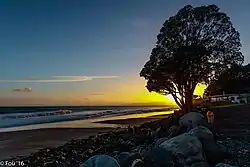Onaero
Onaero is a settlement in northern Taranaki, in the North Island of New Zealand. It is located on State Highway 3 close to the shore of the North Taranaki Bight, 15 kilometres (9.3 mi) east of Waitara.[3] Onaero was the site of the No. 2 Company Redoubt, a British military installation created during the Second Taranaki War by soldiers from the Tikorangi Redoubt in 1865, however it was abandoned several months later.[4]
Onaero | |
|---|---|
 Onaero Beach | |
| Coordinates: 39°00′S 174°21′E | |
| Country | New Zealand |
| Region | Taranaki Region |
| Territorial authority | New Plymouth District |
| Ward |
|
| Community | Clifton Community |
| Electorates | |
| Government | |
| • Territorial Authority | New Plymouth District Council |
| • Regional council | Taranaki Regional Council |
| Area | |
| • Total | 0.15 km2 (0.06 sq mi) |
| Population (June 2023)[2] | |
| • Total | 70 |
| • Density | 470/km2 (1,200/sq mi) |
Demographics
Onaero Beach is defined by Statistics New Zealand as a rural settlement. It covers 0.15 km2 (0.058 sq mi) and had an estimated population of 70 as of June 2023,[2] with a population density of 467 people per km2. It is part of the wider Tikorangi statistical area,[5] which covers 167.79 km2 (64.78 sq mi).[1]
| Year | Pop. | ±% p.a. |
|---|---|---|
| 2006 | 75 | — |
| 2013 | 78 | +0.56% |
| 2018 | 75 | −0.78% |
| Source: [6] | ||
Onaero had a population of 75 at the 2018 New Zealand census, a decrease of 3 people (−3.8%) since the 2013 census, and unchanged since the 2006 census. There were 39 households, comprising 39 males and 36 females, giving a sex ratio of 1.08 males per female. The median age was 57.2 years (compared with 37.4 years nationally), with 6 people (8.0%) aged under 15 years, 6 (8.0%) aged 15 to 29, 39 (52.0%) aged 30 to 64, and 21 (28.0%) aged 65 or older.
Ethnicities were 88.0% European/Pākehā, 16.0% Māori, and 4.0% Pacific peoples. People may identify with more than one ethnicity.
Although some people chose not to answer the census's question about religious affiliation, 52.0% had no religion, and 36.0% were Christian.
Of those at least 15 years old, 18 (26.1%) people had a bachelor's or higher degree, and 6 (8.7%) people had no formal qualifications. The median income was $39,600, compared with $31,800 nationally. 12 people (17.4%) earned over $70,000 compared to 17.2% nationally. The employment status of those at least 15 was that 33 (47.8%) people were employed full-time, and 15 (21.7%) were part-time.[6]
Further reading
General historical works
- Whilst strictly not an historical work (in the sense of being a published book/monograph), the papers of Dick Purdie Jonas (held at "Puke Ariki". Archived from the original on 20 June 2008. in New Plymouth) provide a wealth of historical, archaeological, and anthropological information about this region. See "Jonas, Dick Purdie (ARC2002-166)". Archived from the original on 14 October 2008. Retrieved 26 January 2008.
Environment
- Bristow, Margaret (1978). Onaero-Mohikatino (i.e. Mohakatino) survey (Report). Stratford, [N.Z.]: Taranaki Catchment Commission.
- Jardine, Edward Handforth (1981). Water and land use: part I, Tikorangi-Motunui district: part II, Onaero Catchment (Report). Stratford, [N.Z.]: Taranaki Catchment Commission.
Geology
- Hayward, Bruce W. (1981). Biostratigraphy of Onaero-1 onshore well (Report). Lower Hutt, [N.Z.]: New Zealand Geological Survey, Dept. of Scientific and Industrial Research.
Maori
- See "ARC2002-166 (papers of) Jonas, Dick Purdie". Archived from the original on 14 October 2008. Retrieved 26 January 2008.
Maps
- For a 1969 map of the scenic reserves within north Taranaki (including the Onaero River, whose estuary forms the setting for the community and its beach resort) see "ARC2005-436 Scenic Reserves". Archived from the original on 14 October 2008. Retrieved 26 January 2008. . This is held at "Puke Ariki". Archived from the original on 20 June 2008. in New Plymouth.
Notes
- "ArcGIS Web Application". statsnz.maps.arcgis.com. Retrieved 26 February 2021.
- "Subnational population estimates (RC, SA2), by age and sex, at 30 June 1996-2023 (2023 boundaries)". Statistics New Zealand. Retrieved 25 October 2023. (regional councils); "Subnational population estimates (TA, SA2), by age and sex, at 30 June 1996-2023 (2023 boundaries)". Statistics New Zealand. Retrieved 25 October 2023. (territorial authorities); "Subnational population estimates (urban rural), by age and sex, at 30 June 1996-2023 (2023 boundaries)". Statistics New Zealand. Retrieved 25 October 2023. (urban areas)
- "Onaero Travel Guide". Jasons Travel Media.
- Prickett, Nigel (1999). "BRITISH ARMY AND COLONIAL FORTIFICATIONS IN NORTH TARANAKI, 1865–69". Records of the Auckland Institute and Museum. 36: 5–58. ISSN 1174-9202.
- 2018 Census place summary: Tikorangi
- "Statistical area 1 dataset for 2018 Census". Statistics New Zealand. March 2020. 7017184.